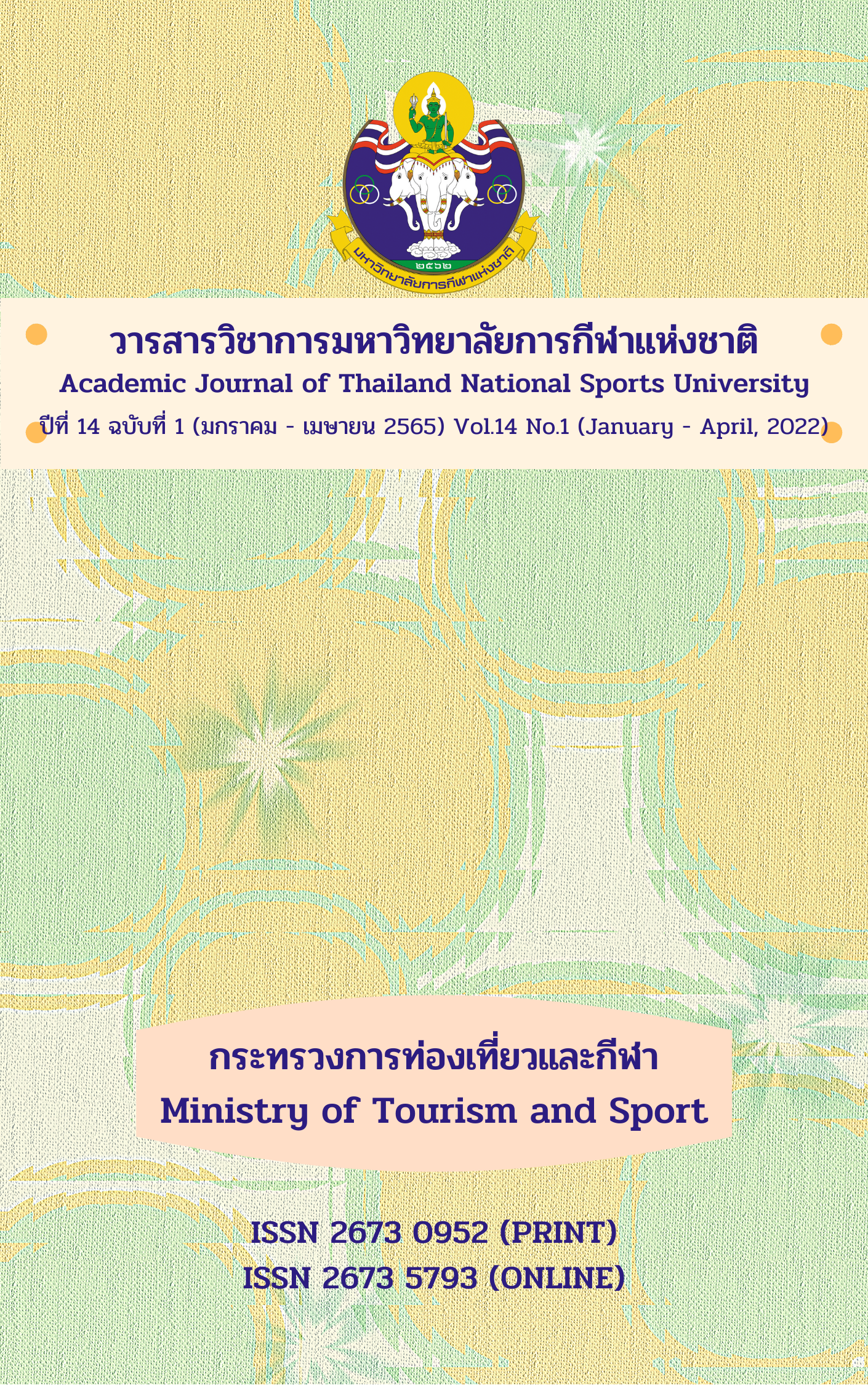EFFECTS OF PHYSICAL EDUCATION LEARNING MANAGEMENT USING CIRCUIT TRAINING ON FUNDAMENTAL MOVEMENT SKILLS OF LOWER PRIMARY SCHOOL STUDENTS
Main Article Content
Abstract
The purposes of this research were to 1) compare the different results before and after the experiment of the experimental group and the control group (Table 1), 2) compare the different results between the experimental group which received physical education learning management using circuit training and control group which received the normal physical education instruction (Table 2). The grade 3 students of the strong primary school between 8 - 9 years were selected by purposive selection and the sample were 64 students in Grade 3 by simple random sampling. The participants were divided into 2 groups. There are 32 students in experimental group which received the physical education learning management using circuit training. The research instruments were comprised of eight physical education learning management using circuit training lesson plans and fundamental test. Another group which received the normal physical education instruction contained 32 students. The research instruments were 8 lessons plans, 1 day a week. Each had 60 minutes and fundamental movement skills test with IOC 0.94 and 0.95. Then the differences of the average t - test scores of fundamental movement skills test were compared before and after the treatment. The results were as follows: 1) the mean score of fundamental movement skills after the treatment of the experimental group was higher than that before the treatment at the significance level of .05 and 2) the mean score of fundamental movement skills after the treatment of the experimental group was higher than that the control group at the significance level of .05. Conclusion: Physical education learning management with using a circuit training on fundamental movement skills of lower primary students can make the students have a better fundamental movement skills.
Article Details

This work is licensed under a Creative Commons Attribution-NonCommercial-NoDerivatives 4.0 International License.
The published article is a copyright of the Academic Journal of Thailand National Sports University. The passage appeared in each article in this academic journal is a perspective of each author which is not related to the journal. Each author is required to be responsible for all components of his/her own article. If there are any mistakes, each author must be responsible for those mistakes on his/her own.
References
Branta Crystal, Haubenstricker John, & Seefeldt Vern. (1984). Age changes in motor skills during childhood and adolescence. Exercise and Sport Sciences Reviews, 12(1), 467 - 520.
E. van Beurden, A. Zask, L. M. Bernett, & U. C. Dietrich. (2002). Fundamental movement skills-How do primary school children perform? The ‘Move it Groove it’ program in rural Australia. Journal of Science and Medicine in Sport, 5(3), 244 – 252.
Hathaichanok Saokeaw, Paiboon Srichaisawat, Wattana Sutipan, and Khajorn Treesopanakorn (2016). The effect of aerobic exercise by circuit training program on the physical fitness of 9-year-old overweight boys. Journal of Graduate Research, 7(2), 223 - 237.
Lubans, D. R., Morgan, P. J., Cliff, D. P., Barnett, L. M., & Okely, A. D. (2010). Fundamental movement skills in children and adolescents: review of associated health benefits. Sports Med, 40(12), 1019 – 1035.
Faculty of Medicine Ramathibodi Hospital Department of Pediatrics, Mahidol University. (2019). Learning for preschool and elementary school children. Retrieved from https://www.youtube.com/watch?v=_-OnD9mapsM
Michael, J., Emma L. J., & Samuel, W. (2017). The effects of 10-week integrated neuromuscular training on fundamental movement skills and physical self - efficacy in 6 – 7 year-old children. School of Life Sciences, Coventry University, Coventry, United Kingdom.
Okely, A. D., & Booth, M. L. (2004). Mastery of fundamental movement skills among children in New South Wales. Prevalence and sociodemographic distribution. J Sci Med Sport, 7(3), 358 - 372.
Phonlaphat Buakaew. (2016). The development of an authentic assessment basic movement for student elementary school (Master’s thesis), Chulalongkorn University.
Robert, M. Malina, & Bertis, B. Little. (2008). Physical activity: The present in the context of the past. American Journal of Human Biology, 20(4), 373 - 391.
Soraya Satongtian. (2012). How to exercise Keep children healthy. Retrieved from http://www.pt.mahidol.ac.th/knowledge/?p=295
Syed Kamaruzaman Syed Ali, Malathyie A/P K. Arumugam, Zahra Ranjbar, Megat Ahmad Kamaluddin Megat Daud, Rahmad Sukor Ab Samad. (2015). The effectiveness of circuit training in enhancing muscle endurance among standard five boys in a primary school. Faculty of Education University of Malaya Kuala Lumpur. International Journal of Physical Education, Sports and Health, 2(1), 11 - 16.
Vorasak Pienchob. (1980). Principles and Methods of Teaching Physical Education. Bangkok: Thai Watanapanich.
Vorasak Pienchob (2005). Collection of Articles about Philosophy, Principles, Teaching Methods, and Measurement for Physical Education Evaluation. Bangkok: Chulalongkorn University Press.


